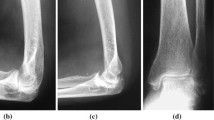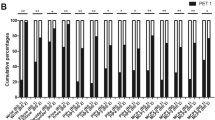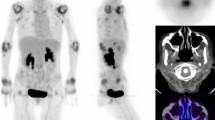Abstract
Background
The degree of 18-fluorodeoxyglucose (FDG) uptake is previously reported to correlate with physical examination and laboratory tests for evaluating disease activity in patients with rheumatoid arthritis. The clinical validity of 18F-FDG positron emission tomography (PET) has not been evaluated in juvenile idiopathic arthritis (JIA).
Objective
To assess the relationship between 18F-FDG PET uptake and disease activity in children with JIA.
Materials and methods
A total of 560 joints in 28 children (mean age, 5.4 years; range, 1–16 years) with JIA who had undergone whole-body 18F-FDG PET before treatment were retrospectively assessed clinically, biochemically and radiographically. PET images were assessed independently by two readers. We investigated the relationships between the degree of synovial 18F-FDG uptake and radiographic and clinical symptoms and laboratory findings.
Results
Joint tenderness and swelling had a positive association with abnormal 18F-FDG uptake in the joint [odds ratio (OR) 5.37, 7.12, respectively]. The standardized uptake value (SUV) max correlated with the neutrophil count, plasma C-reactive protein (CRP), erythrocyte sedimentation rate (ESR) and matrix metalloproteinase (MMP) 3. Joint erosion (OR, 6.17), soft-tissue swelling (OR, 3.77), major joints involvement (OR, 3.50), tenderness (OR, 5.22), and CRP concentration in plasma (OR, 1.81) were positively associated with SUVmax.
Conclusion
The degree of 18F-FDG uptake may be associated with the severity of synovitis in children with JIA.





Similar content being viewed by others
References
Ravelli A, Martini A (2007) Juvenile idiopathic arthritis. Lancet 369:767–778
Petty RE, Southwood TR, Manners P et al (2004) International League of Associations for Rheumatology classification of juvenile idiopathic arthritis: second revision, Edmonton, 2001. J Rheumatol 31:390–392
Lovell DJ, Giannini EH, Reiff A et al (2000) Etarercept in children with polyarticular rheumatoid arthritis. Paediatric Rheumatology Collaborative Study Group. N Engl J Med 342:763–769
Russo RA, Katsicas MM, Zalazko M (2002) Etanercept in systemic juvenile idiopathic arthritis. Clin Exp Rheumatol 20:723–726
Quartier P, Taupin P, Bourdeaut F et al (2003) Efficacy of etanercept for the treatment of juvenile idiopathic arthritis according to the onset type. Arthritis Rheum 48:1093–1101
Gerloni V, Pontikaki I, Gattinara M et al (2005) Efficacy of repeated intravenous infusions of an anti-tumor necrosis factor alpha monoclonal antibody, infliximab, in persistently active, refractory juvenile idiopathic arthritis: results of an open-label prospective study. Arthritis Rheum 52:548–553
Katsicas MM, Russo RA (2005) Use of infliximab in patients with systemic juvenile idiopathic arthritis refractory to etanercept. Clin Exp Rheumatol 23:545–548
Yokota S, Imagawa T, Miyamae T et al (2004) Long-term therapeutic experience of humanized anti-IL-6 receptor monoclonal antibody (aIL-6R Mab) in systemic-onset juvenile idiopathic arthritis (So-JIA). Arthritis Rheum 50:S438
Yokota S, Miyamae T, Imagawa T et al (2005) Clinical study of tocilizumab in children with systemic-onset juvenile idiopathic arthritis. Clin Rev Allergy Immunol 28:231–238
Yokota S, Imagawa T, Mori M et al (2008) Efficacy and safety of tocilizumab in patients with systemic-onset juvenile idiopathic arthritis: a randomized, double-blind, placebo-controlled, withdrawal phase II trial. Lancet 371:998–1006
Reed MH, Wilmot DM (1991) The radiology of juvenile rheumatoid arthritis. A review of the English language literature. J Rheumatol Suppl 31:2–22
Rossi F, Di Dia F, Galipo O et al (2006) Use of Sharp and Larsen scoring methods in the assessment of radiographic progression in juvenile idiopathic arthritis. Arthritis Rheum 55:717–723
Doria AS, Babyn P, Feldman B (2006) A critical appraisal of radiographic scoring systems for assessment of juvenile idiopathic arthritis. Pediatr Radiol 36:759–772
Malattia C, Damasio MB, Magnaguagno F et al (2008) Magnetic resonance imaging, ultrasonography, and conventional radiography in the assessment of bone erosions in juvenile idiopathic arthritis. Arthritis Rheum 59:1764–1772
Pedersen TK, Kuseler A, Gelineck J et al (2008) A prospective study of magnetic resonance and radiographic imaging in relation to symptoms and clinical findings of the temporomandibular joint in children with juvenile idiopathic arthritis. J Rheumatol 35:1668–1675
Wipke BT, Wang Z, Kim J et al (2002) Dynamic visualization of joint specific autoimmune response through positron emission tomography. Nat Immunol 3:366–372
Fonseca A, Wagner J, Yamaga LI et al (2008) (18) F-FDG PET imaging of rheumatoid articular and extraarticular synovitis. J Clin Rheumatol 14:307
Beckers C, Ribbens C, André B et al (2004) Assessment of disease activity in rheumatoid arthritis with (18)F-FDG PET. J Nucl Med 45:956–964
Giannini EH, Ruperto N, Ravelli A et al (1997) Preliminary definition of improvement in juvenile arthritis. Arthritis Rheum 40:1202–1209
Polisson RP, Schoenberg OI, Fischman A et al (1995) Use of magnetic resonance imaging and positron emission tomography in the assessment of synovial volume and glucose metabolism in patients with rheumatoid arthritis. Arthritis Rheum 38:819–825
Goerres GW, Forster A, Uebelhart D et al (2006) F-18 FDG whole-body PET for the assessment of disease activity in patients with rheumatoid arthritis. Clin Nucl Med 31:386–390
Elzinga EH, van der Laken CJ, Comans EF et al (2007) 2-Deoxy-2-[F-18]fluoro-D-glucose joint uptake on positron emission tomography images: rheumatoid arthritis versus osteoarthritis. Mol Imaging Biol 9:357–360
Beckers C, Jeukens X, Ribbens C et al (2006) (18)F-FDG PET imaging of rheumatoid knee synovitis correlates with dynamic magnetic resonance and sonographic assessments as well as with the serum level of metalloproteinase-3. Eur J Nucl Med Mol Imaging 33:275–280
Ju JH, Kang KY, Kim IJ et al (2008) Visualization and localization of rheumatoid knee synovitis with FDG-PET/CT images. Clin Rheumatol 27:S39–S41
Roivainen A, Parkkola R, Yli-Kerttula T et al (2003) Use of positron emission tomography with methyl-11C-choline and 2-18F-fluoro-2-deoxy-D-glucose in comparison with magnetic resonance imaging for the assessment of inflammatory proliferation of synovium. Arthritis Rheum 48:3077–3084
Acknowledgments
The authors thank Jin Lee, Hiroaki Hagiwara, Zenjiro Sekikawa, Keisuke Yoshida, Tomohiro Yoneyama, as well as Masashi Kawaguchi, the research staff of the study for their help with data collection. Gratitude is expressed to Akiko Suzuki, Ryogo Minamimoto and Hirofumi Shibata for their assistance with data analyses.
This work was supported in part by grants from Scientific Research Expenses for Health and Welfare Programs and the Grant-in-Aid for Cancer Research from the Ministry of Health, Labour and Welfare.
Author information
Authors and Affiliations
Corresponding author
Rights and permissions
About this article
Cite this article
Tateishi, U., Imagawa, T., Kanezawa, N. et al. PET assessment of disease activity in children with juvenile idiopathic arthritis. Pediatr Radiol 40, 1781–1788 (2010). https://doi.org/10.1007/s00247-010-1716-5
Received:
Revised:
Accepted:
Published:
Issue Date:
DOI: https://doi.org/10.1007/s00247-010-1716-5




